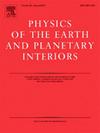2014年云南景谷地震的震源过程
IF 1.9
3区 地球科学
Q2 GEOCHEMISTRY & GEOPHYSICS
引用次数: 0
摘要
2014年景谷6.0级地震发生在滇西南地块nnw向和nne向复杂共轭断裂体系中。我们重新定位了主震震源,反演了3.5级以上地震的震源机制和主震破裂过程,研究了地震序列的震源过程。主震震源定位于100.47°E, 23.40°N, 9.3 km。主震震源机制为150°/76°/179°(走向/倾斜/前倾)。共发生走滑地震21次,正常余震2次,逆冲余震2次。景谷地震序列的平均倾角为78.75°。景谷地震是一次单断层双侧破裂事件。主震的最大滑移量为0.56 m,平均前倾为182°,滑移率为2.12 km/s。主震滑动模型的主滑动块位于距震中150°方向4 km处,深度为4 ~ 9 km。百分之九十的能量是在最初的5.8秒内释放的。景谷地震序列可能由主震主导的两个断层面上的破裂和共轭断层系统内发生的两次5.5 Mw余震组成。本文章由计算机程序翻译,如有差异,请以英文原文为准。

The source process of the 2014 Jinggu earthquake in Yunnan, China
The 2014 Jinggu Mw 6.0 earthquake occurred in the complex conjugate fault system of the Southwest Yunnan Block, comprised of NNW-trending and NNE-trending faults. We relocated the mainshock's hypocenter and inverted the focal mechanisms of earthquakes greater than M 3.5 and the mainshock's rupture process to study the earthquake sequence's source process. The relocation of the mainshock's hypocenter was determined to be at 100.47°E, 23.40°N, and 9.3 km. The focal mechanism of the mainshock is 150°/76°/179°(strike/dip/rake). There are 21 strike-slip earthquakes, 2 normal aftershocks, and 2 thrust aftershocks. The average dip angle of the Jinggu earthquake sequence is 78.75°. The Jinggu earthquake was a single-fault bilateral rupture event. The peak slip, average rake, and slip rate of the mainshock are 0.56 m, 182°, and 2.12 km/s, respectively. The main slip patch of the mainshock slip model was at 4 km in the 150° direction from the epicenter with a depth ranging from 4 km to 9 km. Ninety percent of the energy was released within the first 5.8 s. The Jinggu earthquake sequence may consist of ruptures on two fault planes dominated by the mainshock and two Mw 5.5 aftershocks occurring within the conjugate fault system.
求助全文
通过发布文献求助,成功后即可免费获取论文全文。
去求助
来源期刊

Physics of the Earth and Planetary Interiors
地学天文-地球化学与地球物理
CiteScore
5.00
自引率
4.30%
发文量
78
审稿时长
18.5 weeks
期刊介绍:
Launched in 1968 to fill the need for an international journal in the field of planetary physics, geodesy and geophysics, Physics of the Earth and Planetary Interiors has now grown to become important reading matter for all geophysicists. It is the only journal to be entirely devoted to the physical and chemical processes of planetary interiors.
Original research papers, review articles, short communications and book reviews are all published on a regular basis; and from time to time special issues of the journal are devoted to the publication of the proceedings of symposia and congresses which the editors feel will be of particular interest to the reader.
 求助内容:
求助内容: 应助结果提醒方式:
应助结果提醒方式:


